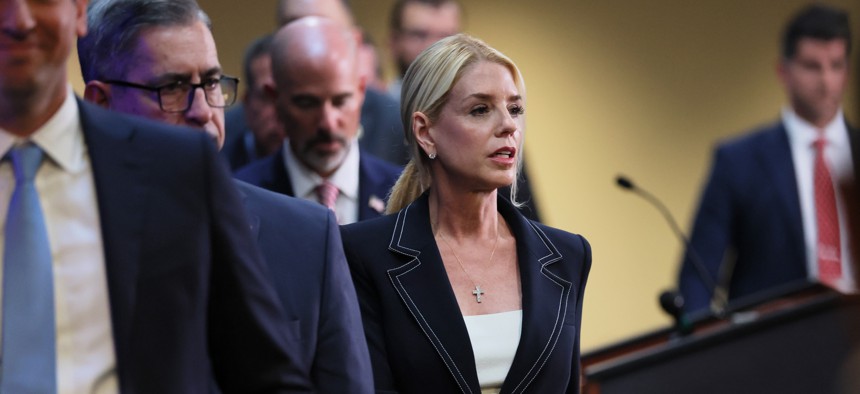
A new Justice Department rule will give Attorney General Pam Bondi wide latitude in selecting officials to oversee asylum and other cases pending before the Executive Office of Immigration Review. Michael M. Santiago / Getty Images
DOJ to grant itself authority to tap any attorney to serve as an immigration judge
The Trump administration is exerting more control over the immigration system as it erases existing standards for individuals who preside over cases during potentially unlimited six-month stints.
The Trump administration will on Thursday grant itself new permission to hire any attorney to serve as an immigration judge on a temporary basis, eschewing longstanding restrictions on who could serve in those roles.
The change gives Attorney General Pam Bondi wide latitude in selecting officials to oversee asylum and other cases pending before the Executive Office of Immigration Review, the Justice Department agency that runs the nation’s immigration courts. That authority could provide President Trump with additional power to withhold legal status from immigrants and expedite his mass deportation efforts.
Since 2014, the department has allowed only former immigration judges, administrative law judges from other agencies or Justice attorneys with at least 10 years of experience related to immigration law to serve as temporary immigration judges, or TIJs. In its update, to be issued Thursday as a final rule, EOIR called those parameters overly restrictive, noting it has hired fewer than a dozen temporary judges since the Obama administration put them into place.
The new rule will permit the EOIR director, with Bondi’s approval, “to designate or select any attorney to serve as a TIJ” for six-month stints, though the department did not cap the number of extensions that it may grant. Employees may come to EOIR as detailees from Justice or other agencies, or as newly hired “special government employees.”
Ensuring the temporary judges have immigration law experience no longer “serves EOIR’s interest,” the agency said in the notice.
“Immigration law experience is not always a strong predictor of success as an IJ, and EOIR has hired individuals from other federal agencies and department components without prior immigration experience who have become successful and exemplary IJs,” it said.
The change will bring the temporary judges’ hiring parameters in closer proximity to those for their permanent counterparts, Justice said.
Adriel Orozco, senior policy counsel at the American Immigration Council, said the Trump administration was putting the integrity of the nation’s immigration courts in jeopardy.
“There is an attempt here to more quickly address the backlog of the immigration court and prioritize speed over justice,” Orozco said, adding the administration wants “more immigration judges on the bench and probably more immigration judges that align with [its] ideologies.”
Because the judges will be up for renewal every six months, he added, the TIJs will have an added incentive to ensure they are “meeting the expectations of leadership.”
EOIR said any suggestion that its new hires would not be “neutral arbiters” of the cases before them amounted to “unsupported accusations.”
The number of new cases arriving before EOIR has plummeted since Trump took office and implemented a crackdown at the border, but the backlog remains at a staggering 3.7 million. The agency, with Congress’ support, has significantly expanded the number of permanent judges to a high of around 700 over the last decade to confront the backlog, but has lost more than 100 of them since Trump took office due to firings and incentivized separations.
The department noted the need for additional judges requires a broader application pool for temporary hires, though Orozco suggested EOIR was itself creating that need by firing dozens of judges and encouraging others to leave.
EOIR said that in selecting temporary judges, it will give primary weight to applicant’s education and employment history. It cited Supreme Court clerkships or involvement in “high-salience, complex litigation” as the type of experience it will target. It added, however, that its director and the attorney general “retain discretion to consider any other factors deemed relevant and to make selections.”
The agency stressed that previous qualification standards for temporary judges made it far too difficult to hire them. Orozco, however, noted EOIR made little effort to bring on TIJs since the 2014 rule was issued because it was hiring so many permanent ones.
EOIR said temporary judges will receive the same “comprehensive” training as their permanent counterparts, but Orozco suggested that would be logistically difficult. Permanent judges receive classroom training and year-long mentorships from existing judges, something that would be difficult to replicate for those serving in six-month stints. That issue, he noted, is compounded by Justice opening up the roles to those with no prior experience in immigration law.
“There's really no conceivable way [to deliver] the same type of training that would be adequate for the context they’re being placed in,” Orozco said.
Share your news tips with us:
Eric Katz: ekatz@govexec.com, Signal: erickatz.28







